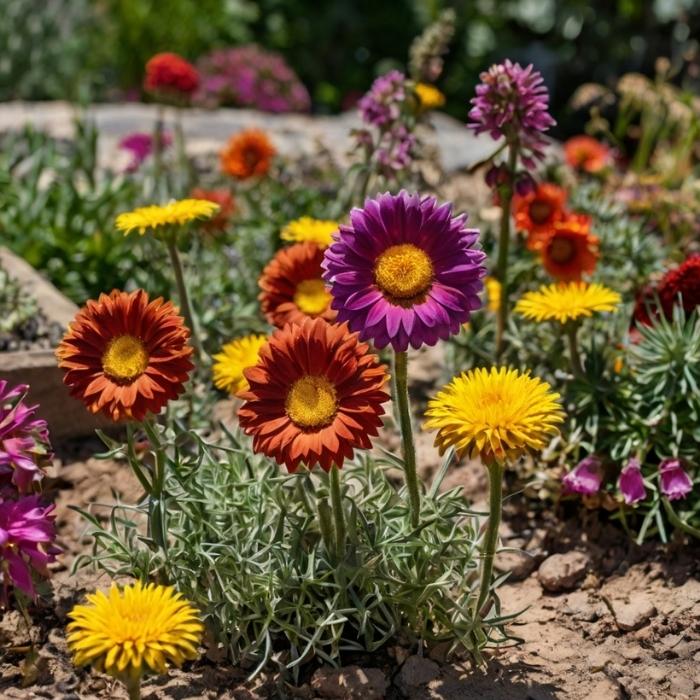The Ultimate Guide to Drought-Tolerant Flowers for Stunning, Low-Maintenance Gardens
Gardening in areas prone to drought or water restrictions can feel like a challenge, but it doesn’t have to mean giving up on a beautiful, thriving garden. Drought-tolerant flowers are the perfect solution, offering vibrant blooms and resilient foliage while requiring minimal water. In this guide, we’ll explore the best drought-tolerant flowers, tips for creating a water-wise garden, and maintenance strategies to keep your plants thriving.
Why Choose Drought-Tolerant Flowers?
Drought-tolerant flowers are specifically adapted to survive with little water, making them an excellent choice for gardens in dry climates or areas with limited rainfall. These plants often feature unique adaptations, such as:
- Deep Root Systems: To access underground water reserves.
- Waxy Leaves: To reduce water loss.
- Small or Fuzzy Leaves: To minimize evaporation.
Beyond their practical benefits, drought-tolerant flowers contribute to sustainable gardening, reduce water bills, and often attract pollinators like bees and butterflies.
Top Drought-Tolerant Flowers for Your Garden
1. Lavender (Lavandula)
Lavender is a classic drought-tolerant flower known for its fragrant purple blooms and silvery foliage. This Mediterranean native thrives in full sun and well-drained soil. Lavender is also a magnet for pollinators, making it a favorite for eco-conscious gardeners.
2. Blanket Flower (Gaillardia)
With its cheerful, daisy-like blooms in shades of red, orange, and yellow, blanket flower adds vibrant color to any garden. It’s hardy, easy to grow, and blooms from summer to fall, even in poor soil conditions.
3. Coneflower (Echinacea)
Coneflowers are beloved for their striking, spiky centers and drooping petals. Available in various colors, including pink, white, and orange, these flowers thrive in dry conditions and attract butterflies and birds.
4. Sedum (Stonecrop)
Sedums are succulents that produce clusters of star-shaped flowers. They’re incredibly low-maintenance and come in various sizes, from ground covers to upright varieties, making them versatile for any garden design.
5. California Poppy (Eschscholzia californica)
The state flower of California, this vibrant orange poppy is a drought-tolerant superstar. It’s self-seeding, thrives in full sun, and adds a pop of color to wildflower gardens.
6. Yarrow (Achillea)
Yarrow is a tough, versatile plant with flat-topped clusters of tiny flowers. It’s available in various colors, including yellow, pink, and white, and is a favorite for attracting beneficial insects.
7. Russian Sage (Perovskia atriplicifolia)
Russian sage features tall spires of lavender-blue flowers and aromatic silver-gray foliage. It’s an excellent choice for adding height and texture to your garden while thriving in dry, sunny locations.
Designing a Drought-Tolerant Garden
Creating a beautiful drought-tolerant garden involves more than just choosing the right plants. Here are some design tips to maximize water efficiency and aesthetic appeal:
1. Group Plants by Water Needs
Organize your garden so that plants with similar water requirements are grouped together. This method, called hydrozoning, ensures efficient irrigation and reduces water waste.
2. Choose Native Plants
Native plants are well-adapted to the local climate and soil conditions, making them naturally drought-tolerant. Incorporating native flowers can also support local wildlife.
3. Use Mulch
A layer of mulch around your plants helps retain soil moisture, regulate temperature, and reduce evaporation. Organic mulches, such as bark or straw, also improve soil health over time.
4. Incorporate Hardscaping
Add pathways, gravel, or decorative rocks to reduce the amount of water-dependent greenery in your garden. Hardscaping elements also create visual interest and structure.
5. Opt for Drip Irrigation
Drip irrigation delivers water directly to the plant roots, minimizing evaporation and runoff. It’s a highly efficient watering method for drought-tolerant gardens.
Caring for Drought-Tolerant Flowers
While drought-tolerant flowers require less water than other plants, they still benefit from proper care. Follow these tips to ensure your flowers thrive:
1. Water Wisely
Water deeply but infrequently to encourage deep root growth. Early morning or late evening is the best time to water, as it reduces evaporation.
2. Prune Regularly
Deadhead spent blooms to encourage new growth and maintain a tidy appearance. Pruning also improves air circulation, reducing the risk of disease.
3. Monitor Soil Health
Drought-tolerant plants prefer well-draining soil. If your soil is heavy clay or compacted, consider amending it with sand or organic matter to improve drainage.
4. Watch for Pests
Even hardy plants can attract pests like aphids or spider mites. Inspect your garden regularly and use natural pest control methods, such as introducing beneficial insects or applying neem oil.
5. Fertilize Sparingly
Most drought-tolerant flowers don’t need heavy fertilization. Use a slow-release, low-nitrogen fertilizer in the spring to support healthy growth.
Benefits of Drought-Tolerant Gardens
In addition to their water-saving properties, drought-tolerant gardens offer several other advantages:
- Low Maintenance: These gardens require less time and effort, making them ideal for busy homeowners.
- Cost Savings: Reduced water usage translates to lower utility bills.
- Eco-Friendly: By conserving water and supporting pollinators, drought-tolerant gardens promote environmental sustainability.
- Year-Round Beauty: Many drought-tolerant flowers are evergreen or have extended bloom periods, ensuring your garden looks attractive throughout the year.
Final Thoughts
Drought-tolerant flowers prove that you don’t need abundant water to create a lush, vibrant garden. By selecting the right plants, designing with water efficiency in mind, and providing proper care, you can enjoy a stunning outdoor space that thrives even in the driest conditions. Whether you’re a seasoned gardener or a beginner, these resilient blooms are a step toward a sustainable and beautiful landscape.
Start planning your drought-tolerant garden today, and watch as it transforms into a colorful oasis that requires less effort and more admiration!

